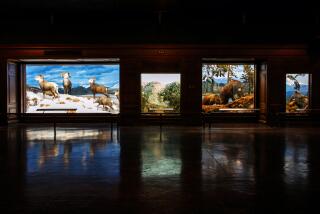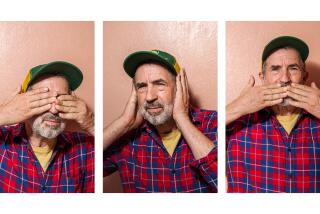Taxidermist Preserves the Nature of the Beast
- Share via
Stuff it--that is what Jerry Drotter prefers to do for a living.
Right now, with hunting season at its peak and fishing at local lakes open, the back room of his taxidermy shop looks like Noah’s ark. On Monday, hunters brought in three deer from Arizona, Colorado and Utah. Jumbo trout are due any day.
It is Drotter’s job to skin the animals and “flesh out” their hides with plastic. The days of stuffing hides with straw are long gone.
Despite what may seem like a contradiction, Drotter said he cares about animals. “But I won’t be trapped into saying I love ‘em.” he said.
Drotter, 38, and his wife Debbie, 36, are the owners of Jerry’s Wildlife Designs Taxidermy. They have run the business on Telegraph Road in Pico Rivera for the past six years. He does the animals; she takes care of the paper work and conducts most of the tours of their showroom for school groups and others.
Jerry Drotter and four employees skin the game and send the hides out for tanning before they “install a new body.” He makes a mold and creates the bodies out of plastic, fitting the skin and making alterations purely on judgment and a knowledge of animals gleaned from watching, chasing, hunting or reading about them.
Teeth and Tongues Made of Plastic
When the form is ready, the skin is glued on. Glass eyes, plastic teeth and plastic tongues replace the originals. Eyelids and muscles are built up to give mammals “the right look,” he said. “We sculpt the perfect specimen.”
Drotter discussed the ins and outs of taxidermy as he gave a tour of the showroom filled with an assortment of about 200 animals.
Pheasants perched on logs. A blue marlin and a sailfish arched across one wall. Plump country chickens sat in bushel baskets, destined for restaurants, kitchens or spots next to the hearth.
“We sell about 600 of those chickens every year,” Drotter said. “A lot of ‘em go to people who haven’t even seen a chicken.” That is one of the satisfactions of his trade, he said.
Picking up a golden pheasant from the Himalayas, Drotter said, “You probably would never see one in your entire life. Most of these birds are almost extinct in the countries they come from. This gives you an opportunity to see something like that.”
The rare animals are bred in the United States and are conserved here, Drotter said. All of the birds in his showroom were “pen-raised.” None came from the wild, he said, adding that taxidermy is a way of saving wild animals that would otherwise die and be buried.
A former construction worker, Drotter enjoys hunting, a sport that he says gives him a chance to walk in the wilds with his 13-year-old son, Jason. He said he favors hunting as a way to keep nature balanced and as a way of obtaining food, but he also is active in wildlife preservation efforts.
The taxidermist, for example, designed a duck scene that will be auctioned to benefit a wetlands project sponsored by Southern California Ducks, an association he belongs to that is dedicated to preserving waterfowl habitats.
Tall and well-built, Drotter said he has been interested in animals “all my life,” and that he became interested in taxidermy when he was 13. “I’ve always liked to fish and hunt,” he said, “but I didn’t like to just shoot to kill or eat. I wanted to do something with it.”
Drotter said he is mostly self-taught in taxidermy, with some training provided by his friend, Arnold Anderson, who took a correspondence course in taxidermy 25 years ago. Anderson, who is now Drotter’s employee, taught Drotter how to mount birds, he said, but he learned to stuff fish and mammals on his own.
Although he said he “won’t get wealthy” in taxidermy, Drotter said he plans to stay in the business or “something that has to do with wildlife.”
Details Are Painted by Hand
Taxidermy, he said, allows him to be creative and “do things with my own hands.” For example, Drotter creates animal scenes such as ducks gathered at a pond or pheasants in flight for law or dental offices.
He also makes replicas that are used for home decoration, props or centerpieces, hand-painting the details himself. To get the colors right, he sometimes consults books. But capturing the original hues can be difficult.
“You get a dead fish and you don’t get a true color,” Drotter said. “It’s hard to find a picture of what they should look like.”
The trade also has its share of strange requests.
“We get a lot of calls for dogs and cats,” Drotter said. “Pets? We don’t do ‘em. That’s when you’d start getting a lot of frowns: ‘How could you? You animal.’ ”
The other day, his wife said, a man showed up with a couple of alligator heads that were used as bookends and needed repair. A Lancaster resident who raises movie animals recently sent in a llama skin. In the deep freeze, a giraffe hide was waiting to be made into a rug.
Other than people and pets, Dotter said with pride, “We can do anything.”






